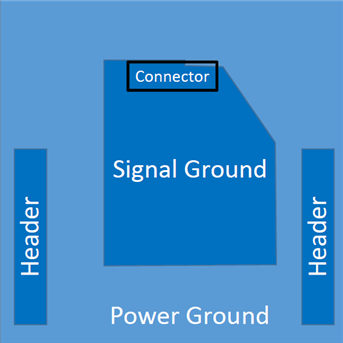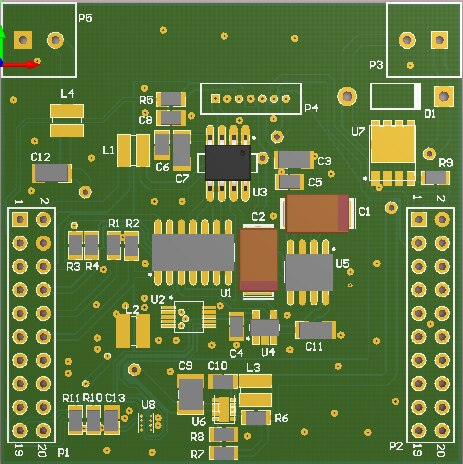Update
A Riddle: How many times in three weeks can a 1 year old child catch sick? The correct answer seems to be 3 times ...
Previous Posts
In The Air: Epidose 1: Introduction
In The Air: Episode 2 - Preparing for Surface Mount Work
In The Air: Episode 3 - Surface Mount Beginnings
In The Air: Episode 4 - Inductors
Introduction
I have finished my Booster Pack design. Figure 1 shows the top and bottom layers. Note, I am an Altium user so the display of the board layers may be unfamiliar to you if you are an Eagle user. If you are familiar with TI's Booster Packs, you'll recognize the characteristic 20 pin headers on opposing sides of the board. In my last post I discussed choosing inductors for filtering/decoupling grounds and power supplies. Accordingly, we will discuss the layout of those inductors and separating grounds for quiet sensor performance in this post.
Figure 1: Bottom (left) and top (right) layers for my Booster Pack design.
Connecting Grounds
The general approach I have adopted is shown in Figure 3. The signal ground is like an island surrounded by the power ground, and the only way to get to the signal ground is through an inductor. The connector is on the boundary between the two grounds because the sensor requires both power and signal ground. I've created an annotated version of the board layout of Figure 1 and produced it in Figure 4. I have labelled the sensor interface, signal ground, and power ground. The power ground is directly connected to the ground of the C3200 through the Booster Pack header connections, and the signal ground is connected to the power ground through the aforementioned inductor.
Figure 3: Basic idea of the Particle Counter Booster Pack.
Figure 4: Annotated Figure 1 showing the sensor interface, signal ground, and power ground.
In Figure 5 I've zoomed in on the board so the signal ground is more visible, and the ground connecting inductor can be seen in the lower left (L2). You can't see the pads from the component because I used Seeedstudio Fusion for my PCBs, and Seeed Studio's design rules don't use a thermal relief pad connection by default. I'm not sure why, but that's the way it loaded. I didn't personally care for this project because I will be hand building the boards, so I left it alone. If I had loaded the rules before designing the board I may have changed it, but I loaded the design rules after. Disclaimer: especially in mass runs, use thermal reliefs on your ground connections to components as it will prevent tombstoning components during reflow.
Figure 5: Zoomed view of the top layer.
The 3D render of the board is shown in Figure 6. You can clearly see the pads for the inductor L2 in the lower left. I didn't bother using models for any components unless they were supplied by default, because I have no concern for height tolerances with this board. At this point in the design you may be wondering, why did he only use a single inductor, and not tie the grounds together at multiple points? The short answer is you'd be creating a ground loop, which can be a terrible problem to troubleshoot. You can look up the analysis for ground loops on PCBs, but if you only connect the grounds at one point you won't have to worry about it. You may have other issues, but a ground loop will not be one of them.
Figure 6: 3D Render of Particle Counter Booster Pack.
Power Supply Decoupling
In my last blog I spoke of decoupling power supplies as well as grounds. I've reproduced the schematic showing these decouplings in Figure 7.
You can see L2 is connecting the grounds, but what about L1; how is that implemented? In the same way. The inductor pads must straddle the gap between the power and signal ground. If you look back at Figure 5, you can clearly see L1 near the upper left straddling the ground boundary.
Figure 7: Decoupling inductors
Still Confused?
How about a video explaining it then!
Final Remarks
I ordered my board. It was only $10 USD from Seeed Studio for 10 pieces. No one else could compete with that price, so I had to choose them. I've got my bill of materials ready to go, I'm just waiting to hear back about the possibility of samples from TI. Every IC on this board is made by TI, which was a bit of a challenge for me. Hopefully everything can arrive in time to put it together and write some software.






Top Comments
-

mcb1
-
Cancel
-
Vote Up
0
Vote Down
-
-
Sign in to reply
-
More
-
Cancel
-

michaelwylie
in reply to mcb1
-
Cancel
-
Vote Up
+3
Vote Down
-
-
Sign in to reply
-
More
-
Cancel
Comment-

michaelwylie
in reply to mcb1
-
Cancel
-
Vote Up
+3
Vote Down
-
-
Sign in to reply
-
More
-
Cancel
Children